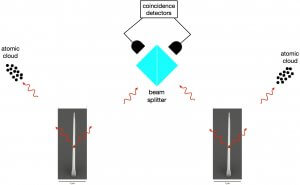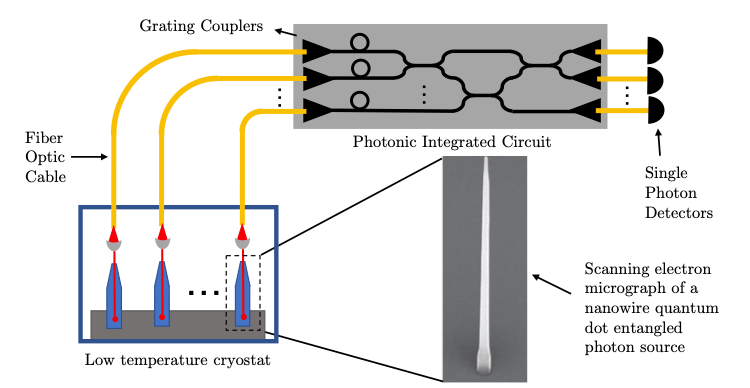Summary
Losses in physical channels, such as optical fibres, limit existing quantum communication systems to modest distance ranges. Since amplification of quantum signals is fundamentally not possible, we look to extend the range and functionality of these quantum channels by adding quantum memory nodes that can daisy-chain multiple lengths of quantum channels through entanglement and thus extend the communication distance — an approach known as ‘quantum repeater’. Quantum repeaters are by necessity hybrid devices, as they connect flying qubits (photons) to small processors for error correction and privacy amplification. In this project we develop a two-node proof-of-principle hybrid quantum repeater system. We generate entangled photon pairs from quantum dots embedded in semiconductor nanowire and store them in atomic quantum memories following a frequency up-conversion. We expect this will enable quantum key distribution over long distances at rates exceeding those possible through a direct link. The photon-pair sources, the frequency converters, as well as the quantum memories will be implemented in compact on-chip platforms. This novel approach combines the advantages available from a deterministic and tunable solid-state source of bright entangled photon pairs with the potential for high-efficiency long-lived quantum memory that is achievable with laser cooled atoms. The ultimate goal is to achieve a working pair of quantum repeater nodes at practically relevant wavelengths that would lead to useful rates for long-distance quantum key distribution.

Figure 1. The two quantum dots (red triangles embedded in semiconductor nanowires) produce pairs of entangled photons. One photon from each pair is stored in an atomic ensemble memory, while the other photon is sent into a coincidence measurement setup, which generates entanglement between the two atomic ensembles.
Related Content

Photonic Quantum Processor
Photonic quantum processors based on integrated quantum photonic circuits require entangled photon pairs to perform quantum computations. However, current state-of-the-art technologies utilize probabilistic entangled photon sources with limited pair-extraction efficiencies, negatively affecting the computation speed. This project aims to boost the speed of on-chip quantum operations by using bright, on-demand entangled photon sources with an […]
April 24, 2023

Metasurfaces for high-efficiency parametric downconversion and complex quantum state generation
Summary Entangled photon sources are crucial for quantum computing, quantum sensing, and quantum communication. Of growing importance are sources relying on spontaneous parametric downconversion (SPDC). Unfortunately, these sources of entangled photons are often constrained by momentum conservation laws. To overcome this limitation and expand the possibility of quantum state engineering, we intend to use metasurfaces […]
February 1, 2023

Quantum Simulations of Fundamental Interactions
Summary To address questions in modern physics such as “what is the structure of matter inside neutron stars?” we need better computational methods to evaluate the interplay of fundamental forces between elementary particles. To-date the response to such questions rests on numerical computer simulations that are inherently limited. In this project, we develop new theoretical […]
April 18, 2019

Quantum Computational Resources in the Presence of Symmetry
Summary Fault-tolerance is essential to the performance of quantum technologies, but known schemes are extremely resource intensive. Thus, improving existing schemes or inventing new schemes is of central importance. This joint project is based on the realization that fault-tolerance schemes make use of symmetries in fundamental ways, and that studying the problem of fault tolerance […]
March 13, 2019

